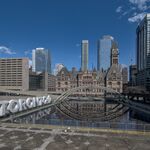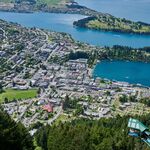To be fair I'm not criticizing a vague notion about using mainline rail for the RL, rather the specific post/fantasy further up the page involving shuttering swaths of mainline rail so as to bring two subway lines to a point in Richmond Hill.
My apologies if I misunderstood your position on that. To further clarify, it wouldn't be 'mainline' per-se, but as another poster described it, 'mainline compatible'. I can't think of any case of 'RER in Tunnel' that's considered 'mainline' in terms of loading gauge. Track gauge, absolutely. It would be standard. The tunnel would be more like Crosstown but with 25kV AC catenary instead of low DC voltage. 25kV AC is of course what Metrolinx is proposing to use for GO electrification, as it's the de-facto int'l standard. LRT's can be ordered with the option to run on both, as is done in Paris and elsewhere, as can EMUs.
Still a goofy routing for an RL though, even on the lower section.
Lower section (south of Don Mills) for RER in Tunnel will run along almost the same route now being proposed for subway, save that curve radius might have to be relaxed, depending on the length of the EMUs. (latest TTC carsections are 23m, Aventra 345 are 24m)
https://en.wikipedia.org/wiki/British_Rail_Class_345
North from Don Mills to Steeles, the RER in tunnel surfaces to join the present Bala alignment which would be doubled and electrified at least in sections owned by Metrolinx. North of Steeles would require a separate approach if extended to RH.
I am talking North of Steeles, like most are suggesting. They think they could use the Bala Sub to get to RH terminal.
That's an assumption on your part. Any foray to connect to RH from that point would be no more complex than the present hare-brained talk of extending subway Line 1 to RH. This is to be the "Relief Line"...is it not? Then use the 'relief' to do as much as possible with one investment that's compatible with surrounding regional transportation, not TTC to Timbuktu.
One can hypothetically squeeze a transit corridor in next to the CN trackage, but I’m not sure it would fit without expropriating adjoining land, and CN will be very protective of its own expansion needs. One can’t just run a TBM along under the train tracks.
Options would have to be studied north of Steeles, doubtless, but if York Region wants better connectivity, then York Region is going to have to have to make some decisions, and Doug Ford besides, logic indicates surface routing with electric RER EMU where possible, tunneled where surface grade is impractical. Crossrail is 6.2 metres in diameter tunnel. That's running fully mainline compatible trains already in production and running, based on models that have been running elsewhere for a few years now. Crosstown, for comparison, is 6.75 metres dia bore.
Crosstown sets a precedent for Toronto tunneling that can be used for *mainline compatible EMUs*, grade angle besides. Why in the world would Toronto wish to keep turning back the clock to keep building out an incompatible subway to the regions, when the regions are already connected with a standard we should be building to match? The decision has been made to use standard gauge track for LRTs. The same logic should be applied to using single deck RER EMUs for 'relieving' the subway, and being able to continue out to the regions as far as the tracks are electrified. In theory, it would be possible for VIA HFR to loop into Toronto's core. That's how connected the core could be.




